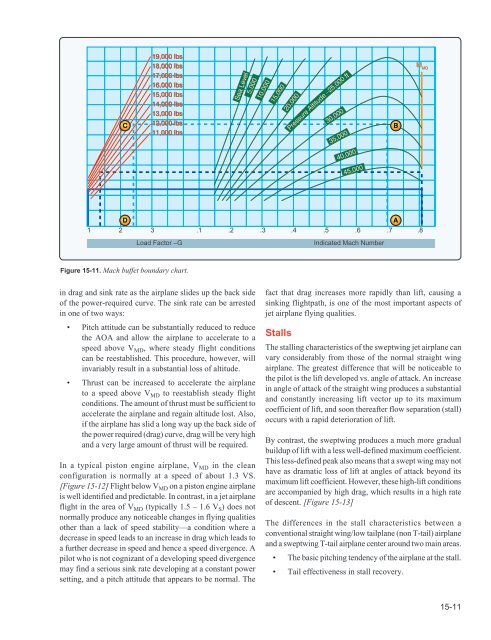You also want an ePaper? Increase the reach of your titles
YUMPU automatically turns print PDFs into web optimized ePapers that Google loves.
C<br />
19,000 lbs<br />
18,000 lbs<br />
17,000 lbs<br />
16,000 lbs<br />
15,000 lbs<br />
14,000 lbs<br />
13,000 lbs<br />
12,000 lbs<br />
11,000 lbs<br />
5,000<br />
Sea Level<br />
10,000<br />
15,000<br />
20,000<br />
30,000<br />
Pressure Altitude –25,000 ft<br />
35,000<br />
B<br />
M MO<br />
40,000<br />
45,000<br />
D<br />
A<br />
1 2 3 .1 .2 .3 .4 .5 .6 .7 .8<br />
Load Factor –G<br />
Indicated Mach Number<br />
Figure 15-11. Mach buffet boundary chart.<br />
in drag and sink rate as the airplane slides up the back side<br />
of the power-required curve. The sink rate can be arrested<br />
in one of two ways:<br />
• Pitch attitude can be substantially reduced to reduce<br />
the AOA and allow the airplane to accelerate to a<br />
speed above V MD , where steady flight conditions<br />
can be reestablished. This procedure, however, will<br />
invariably result in a substantial loss of altitude.<br />
• Thrust can be increased to accelerate the airplane<br />
to a speed above V MD to reestablish steady flight<br />
conditions. The amount of thrust must be sufficient to<br />
accelerate the airplane and regain altitude lost. Also,<br />
if the airplane has slid a long way up the back side of<br />
the power required (drag) curve, drag will be very high<br />
and a very large amount of thrust will be required.<br />
In a typical piston engine airplane, V MD in the clean<br />
configuration is normally at a speed of about 1.3 VS.<br />
[Figure 15-12] Flight below V MD on a piston engine airplane<br />
is well identified and predictable. In contrast, in a jet airplane<br />
flight in the area of V MD (typically 1.5 – 1.6 V S ) does not<br />
normally produce any noticeable changes in flying qualities<br />
other than a lack of speed stability—a condition where a<br />
decrease in speed leads to an increase in drag which leads to<br />
a further decrease in speed and hence a speed divergence. A<br />
pilot who is not cognizant of a developing speed divergence<br />
may find a serious sink rate developing at a constant power<br />
setting, and a pitch attitude that appears to be normal. The<br />
fact that drag increases more rapidly than lift, causing a<br />
sinking flightpath, is one of the most important aspects of<br />
jet airplane flying qualities.<br />
Stalls<br />
The stalling characteristics of the sweptwing jet airplane can<br />
vary considerably from those of the normal straight wing<br />
airplane. The greatest difference that will be noticeable to<br />
the pilot is the lift developed vs. angle of attack. An increase<br />
in angle of attack of the straight wing produces a substantial<br />
and constantly increasing lift vector up to its maximum<br />
coefficient of lift, and soon thereafter flow separation (stall)<br />
occurs with a rapid deterioration of lift.<br />
By contrast, the sweptwing produces a much more gradual<br />
buildup of lift with a less well-defined maximum coefficient.<br />
This less-defined peak also means that a swept wing may not<br />
have as dramatic loss of lift at angles of attack beyond its<br />
maximum lift coefficient. However, these high-lift conditions<br />
are accompanied by high drag, which results in a high rate<br />
of descent. [Figure 15-13]<br />
The differences in the stall characteristics between a<br />
conventional straight wing/low tailplane (non T-tail) airplane<br />
and a sweptwing T-tail airplane center around two main areas.<br />
• The basic pitching tendency of the airplane at the stall.<br />
• Tail effectiveness in stall recovery.<br />
15-11


